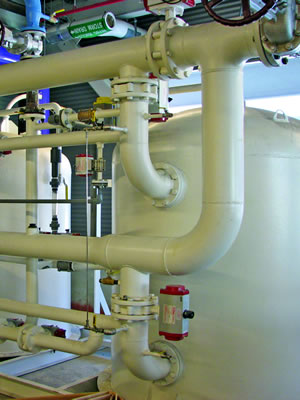WSS-Series Water Softening System
An ion exchange softener can reduce or eliminate hardness problems.
A typical water softener has a pressure vessel partially filled with ion exchange resin, consisting of highly porous plastic beads loaded with "exchange sites" that preferentially remove "hard" ions and replace them with a "soft" ion, sodium. A softener system also includes a brine tank to provide a source of sodium for regenerating the resin and hydraulic controls to direct the flow of water through the softener during service and regeneration.
At the beginning of the softening cycle, sodium ions occupy the resin exchange sites. As water passes through it, the resins stronger attraction for the "hard" ions causes it to take on the "hard" ions and give up the sodium ions. Over time, the sites fill up with "hard" ions, requiring the resin to be regenerated to restore its softening capability.
The regeneration cycle consists of three stages: a preliminary backwash, an ion-exchange regeneration, and two-stage rinse. During the backwash stage, an upward flow of water enters the bottom of the vessel loosening the resin bed and flushing away any suspended particles. The backwash usually lasts about 10 minutes.

When regeneration is complete, the resin is rinsed. First, with a slow down flow through the resin bed to displace the spent brine, followed by a fast down flow, or purge, to flush all the remaining brine from the vessel.
All softener vessels are ASME Code designed and stamped. Materials of construction can be either composite, steel, or alloy. Manways and handholes are sized to suit the internals and service. Steel vessels are epoxy lined and painted with structural steel legs.
Standard internals and face piping are schedule 80 PVC, but can be available in other materials. The inlet distributor consists of either a hub or header with drilled laterals; the outlet collector consists of a hub or header with slotted laterals. The selection of a hub or header arrangement is dependent upon the size of the filter vessel. Both internal and face piping are factory supported.
Standard valving is pneumatically actuated. For line sizes 2" and smaller, ball valves are utilized; in larger line sizes, butterfly valves.
A PLC Controller to automate the backwash, rinse, and in service cycles is standard with the unit. The system is completely factory assembled and tested.
Available Options...
- Automation Delete
- Stainless Steel or Alloy Piping
- Stainless Steel or Alloy Internals
- Custom Instrumentation
- Sub-Surface Wash Header
- Air Scour header / Blower
- Valve Upgrades
- Sight Glasses
- Resin Trap
- Multiple / Alternating Units
- Manway Options
- Lining Options
- Paint Options
- Relief Valve
- Auto Sanitization
- Regenerant System (Brine)
- Brine Maker / Silo System
